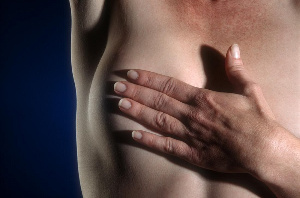 File photo of a lady examining her breast
File photo of a lady examining her breast
In a global effort to raise awareness on breast cancer, the World Health Organisation in 2015 designated October as Pink Month.
Pink Month is a month where efforts to educate those concerned about the disease, including early identification and signs and symptoms associated with breast cancer.
It noted that yearly, breast cancer kills more than 500,000 women around the world. In resource-poor settings, a majority of women with breast cancer are diagnosed at an advanced stage of disease, resulting in low survival rates.
The apex health body defines breast cancer as “a disease in which abnormal breast cells grow out of control and form tumours. If left unchecked, the tumours can spread throughout the body and become fatal.”
Breast cancer cells begin inside the milk ducts and/or the milk-producing lobules of the breast. The earliest form (in situ) is not life-threatening. Cancer cells can spread into nearby breast tissue (invasion). This creates tumours that cause lumps or thickening.
Invasive cancers can spread to nearby lymph nodes or other organs (metastasize). Metastasis can be fatal. However, treatment is based on the person, the type of cancer and its spread.
Breast cancers may spread to other areas of the body and trigger other symptoms. Often, the most common first detectable site of spread is to the lymph nodes under the arm although it is possible to have cancer-bearing lymph nodes that cannot be felt.
Breast cancer occurs in every country in the world and approximately 0.5–one per cent of breast cancers occur in men while the female gender is the strongest breast cancer risk factor. The treatment of breast cancer in men follows the same principles of management as for women.
In 2020, there were 2.3 million women diagnosed with breast cancer and 685,000 deaths globally. As of the end of 2020, there were 7.8 million women alive who were diagnosed with breast cancer in the past 5 years, making it the world’s most prevalent cancer. Breast cancer occurs in every country of the world in women at any age after puberty but with increasing rates in later life, WHO disclosed in a publication.
Signs and Symptoms
Some of the symptoms of breast cancer can include: a breast lump or thickening, often without pain; change in size, shape or appearance of the breast; dimpling, redness, pitting or other changes in the skin; change in nipple appearance or the skin surrounding the nipple (areola); abnormal or bloody fluid from the nipple.
Risk Factors
While family history of breast cancer increases the risk of breast cancer, other risk factors of the cancer include: Age, harmful use of alcohol, family history of breast cancer, history of radiation exposure, tobacco use and postmenopausal hormone therapy, reproductive history (such as age that menstrual periods began and age at first pregnancy), obesity.
Meanwhile, “most women diagnosed with breast cancer do not have a known family history of the disease. Lack of a known family history does not necessarily mean that a woman is at reduced risk,” the WHO noted.
Treatment
Breast cancer treatment is tailored based on the cancer subtype and its stage of progression. The approach varies depending on whether the cancer is localized to the breast (stages 0-I) or has spread to lymph nodes or other parts of the body (stages II-IV).
To minimize the risk of recurrence, doctors often use a combination of treatments, including surgery, radiation therapy, chemotherapy, hormone therapy, and targeted therapy.
Early detection is crucial, and individuals with an abnormal breast lump, regardless of pain, should seek medical care promptly. While most breast lumps are non-cancerous, prompt evaluation allows for successful treatment if cancer is detected and the tumour is small and localized.
Cancerous cells have the potential to spread to other organs, such as the lungs, liver, brain, and bones, leading to additional symptoms like bone pain or headaches. Timely medical intervention increases the likelihood of successful treatment and improved outcomes. Regular screenings and self-examinations are essential for early detection and effective management of breast cancer.
Some of the treatments include: surgery to remove the breast tumour, radiation therapy to reduce recurrence risk in the breast and surrounding tissues, and medications to kill cancer cells and prevent spread, including hormonal therapies, chemotherapy or targeted biological therapies.
